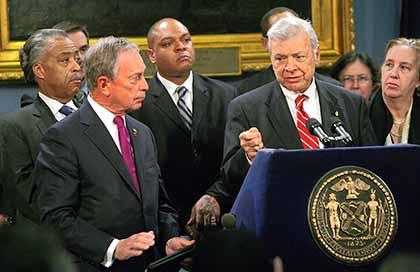By Anna Gustafson and Philip Newman
City and borough officials zeroed in on elections this week, with Queens officials cheering Mayor Michael Bloomberg’s call for reforms to state voting laws and City Council members holding a public hearing about problems during November’s general election.
Bloomberg proposed changes to the state election law Monday that he said would make voting more convenient for residents and encourage voter turnout. New York had the lowest voter turnouts in the country in November, according to city officials.
“Low voter turnout in the past election serves to highlight the need to modernize New York’s election system,” said state Sen. Joseph Addabbo (D-Howard Beach), chairman of the Senate Elections Committee. “I am pleased to work together with Mayor Bloomberg, [Council] Speaker [Christine] Quinn and my colleagues in the state Legislature to fight for reforms, including early voting, easing voter registration and simplifying the ballot.”
Quinn and the Council Committee on Government Operations held a hearing on the November election at City Hall just after Bloomberg called for reform Monday. Councilman Peter Vallone (D-Astoria) was one of the committee members who attended the hearing.
“We have concluded there was no ‘royal screw-up’ on Nov. 2 unlike in the primary election,” Quinn said, using the term Bloomberg employed in describing the primary. “But we cannot be satisfied by a situation that was a little bit better than in the primary.”
The Council speaker then peppered Board of Elections officials with questions about late-opening polling places, difficult-to-read print, malfunctioning scanners and how voting totals were arrived at. The New York Times reported the city BOE “found” nearly 200,000 ballots after recounting the vote, which represents about 17 percent of the total vote. In Queens, there was a one in three chance a resident’s ballot was not counted, which adds up to about 80,000 votes, according to the Times.
This was the first general election that New York used the new voting system mandated by the federal Help America Vote Act. The new system made voters select their candidates by filling out ovals — something reminiscent of multiple-choice tests in schools — on a paper ballot that was fed into the scanner. The scanner then recorded the voter’s choice and the physical evidence of the ballot remained.
“We in New York state have the hideous distinction of having the lowest voter turnout in the United States,” Quinn said. “We must restore confidence in the voters.”
New York had the lowest percentage of voters turn out to vote this year than anywhere else in the country, ranking below Texas and Utah, according to the United States Election Project. About 32 percent of the 13.4 million New York voters turned in a ballot, according to state results.
In order to restore that confidence, Bloomberg said changes must be made to state election law that would create an early voting period, allow residents to fill out their ballots at home and bring them to a polling site, extend the registration deadline and simplify the ballot design. New York is the only state in the country that does not offer any of the following — early voting, no-excuse absentee voting, same-day registration, online registration or a party switch within six months of a primary, the mayor noted.
“I wholeheartedly endorse Mayor Bloomberg’s plan to wake up the state Legislature and the Board of Elections to get New Yorkers back to the polls,” said former Council Speaker Peter Vallone Sr. “Too many have given their ‘Lives, Fortunes and Sacred honor’ just so we can vote.”
Dawn Sandow, deputy director of the BOE, acknowledged that three of the city’s 1,358 polling places were late opening because custodians showed up late to unlock their buildings. Sandow said the city BOE was short of both money and personnel.
“The challenge of implementing the most fundamental change in the electoral administrations system of this nation’s largest city was monumental,” Sandow said. “We have repeatedly stated that this would have been a challenge under any circumstance,” Sandow said. “At a time when everyone clearly anticipated historic changes, the board has been underfunded by more than $21.9 million in the current fiscal year.”
Reach reporter Anna Gustafson by e-mail at agustafson@cnglocal.com or by phone at 718-260-4574.


































